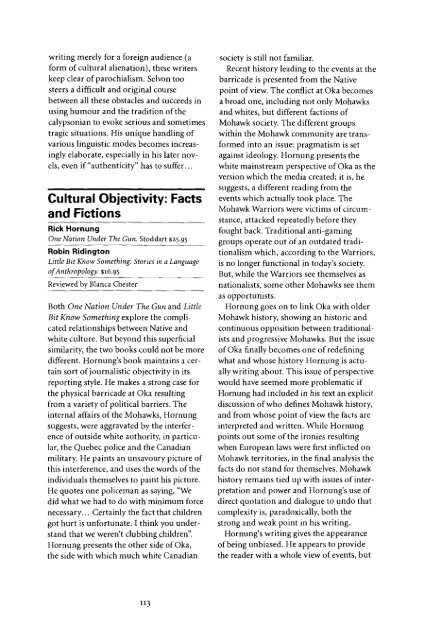To All Appearances A Lady - University of British Columbia
To All Appearances A Lady - University of British Columbia
To All Appearances A Lady - University of British Columbia
Create successful ePaper yourself
Turn your PDF publications into a flip-book with our unique Google optimized e-Paper software.
writing merely for a foreign audience (a<br />
form <strong>of</strong> cultural alienation), these writers<br />
keep clear <strong>of</strong> parochialism. Selvon too<br />
steers a difficult and original course<br />
between all these obstacles and succeeds in<br />
using humour and the tradition <strong>of</strong> the<br />
calypsonian to evoke serious and sometimes<br />
tragic situations. His unique handling <strong>of</strong><br />
various linguistic modes becomes increasingly<br />
elaborate, especially in his later novels,<br />
even if "authenticity" has to suffer...<br />
Cultural Objectivity: Facts<br />
and Fictions<br />
Rick Hornung<br />
One Nation Under The Gun. Stoddart $25.95<br />
Robin Ridington<br />
Little Bit Know Something: Stories in a Language<br />
<strong>of</strong> Anthropology. $16.95<br />
Reviewed by Blanca Chester<br />
Both One Nation Under The Gun and Little,<br />
Bit Know Something explore the complicated<br />
relationships between Native and<br />
white culture. But beyond this superficial<br />
similarity, the two books could not be more<br />
different. Hornung's book maintains a certain<br />
sort <strong>of</strong> journalistic objectivity in its<br />
reporting style. He makes a strong case for<br />
the physical barricade at Oka resulting<br />
from a variety <strong>of</strong> political barriers. The<br />
internal affairs <strong>of</strong> the Mohawks, Hornung<br />
suggests, were aggravated by the interference<br />
<strong>of</strong> outside white authority, in particular,<br />
the Quebec police and the Canadian<br />
military. He paints an unsavoury picture <strong>of</strong><br />
this interference, and uses the words <strong>of</strong> the<br />
individuals themselves to paint his picture.<br />
He quotes one policeman as saying, "We<br />
did what we had to do with minimum force<br />
necessary... Certainly the fact that children<br />
got hurt is unfortunate. I think you understand<br />
that we weren't clubbing children".<br />
Hornung presents the other side <strong>of</strong> Oka,<br />
the side with which much white Canadian<br />
society is still not familiar.<br />
Recent history leading to the events at the<br />
barricade is presented from the Native<br />
point <strong>of</strong> view. The conflict at Oka becomes<br />
a broad one, including not only Mohawks<br />
and whites, but different factions <strong>of</strong><br />
Mohawk society. The different groups<br />
within the Mohawk community are transformed<br />
into an issue: pragmatism is set<br />
against ideology. Hornung presents the<br />
white mainstream perspective <strong>of</strong> Oka as the<br />
version which the media created; it is, he<br />
suggests, a different reading from the<br />
events which actually took place. The<br />
Mohawk Warriors were victims <strong>of</strong> circumstance,<br />
attacked repeatedly before they<br />
fought back. Traditional anti-gaming<br />
groups operate out <strong>of</strong> an outdated traditionalism<br />
which, according to the Warriors,<br />
is no longer functional in today's society.<br />
But, while the Warriors see themselves as<br />
nationalists, some other Mohawks see them<br />
as opportunists.<br />
Hornung goes on to link Oka with older<br />
Mohawk history, showing an historic and<br />
continuous opposition between traditionalists<br />
and progressive Mohawks. But the issue<br />
<strong>of</strong> Oka finally becomes one <strong>of</strong> redefining<br />
what and whose history Hornung is actually<br />
writing about. This issue <strong>of</strong> perspective<br />
would have seemed more problematic if<br />
Hornung had included in his text an explicit<br />
discussion <strong>of</strong> who defines Mohawk history,<br />
and from whose point <strong>of</strong> view the facts are<br />
interpreted and written. While Hornung<br />
points out some <strong>of</strong> the ironies resulting<br />
when European laws were first inflicted on<br />
Mohawk territories, in the final analysis the<br />
facts do not stand for themselves. Mohawk<br />
history remains tied up with issues <strong>of</strong> interpretation<br />
and power and Hornung's use <strong>of</strong><br />
direct quotation and dialogue to undo that<br />
complexity is, paradoxically, both the<br />
strong and weak point in his writing.<br />
Hornung's writing gives the appearance<br />
<strong>of</strong> being unbiased. He appears to provide<br />
the reader with a whole view <strong>of</strong> events, but<br />
113

















